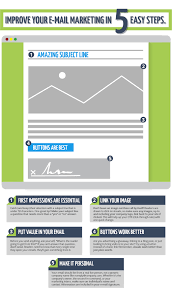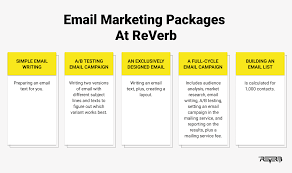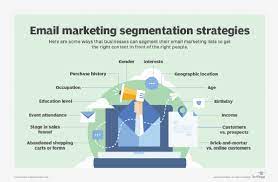Title: The Ultimate Email Marketing Tutorial: Boost Your Business with Effective Strategies
Introduction:
Email marketing has become a cornerstone of digital marketing strategies, providing businesses with a direct and effective way to reach their target audience. In this comprehensive tutorial, we will explore the key elements of successful email marketing campaigns and provide you with practical tips to maximize your results.
Building an Engaging Email List:
The foundation of any successful email marketing campaign is a high-quality and engaged email list. Start by offering valuable content or incentives on your website to encourage visitors to subscribe. Ensure that the opt-in process is seamless and transparent, and always seek permission before sending emails.
Crafting Compelling Email Content:
Once you have a solid subscriber base, it’s time to focus on creating engaging email content. Personalization is key – address recipients by name and segment your list based on demographics or preferences. Craft attention-grabbing subject lines that entice recipients to open your emails, and use concise yet compelling copy that delivers value.
Designing Eye-Catching Emails:
Visual appeal plays a crucial role in capturing readers’ attention. Use professional email templates that are mobile-responsive and visually appealing across different devices. Incorporate relevant images, videos, or infographics to enhance the visual appeal of your emails while maintaining a clean and uncluttered layout.
Optimizing for Deliverability:
To ensure your emails land in recipients’ inboxes rather than spam folders, it’s essential to optimize for deliverability. Maintain a healthy sender reputation by avoiding spam trigger words, regularly cleaning your email list, and utilizing double opt-ins to verify subscribers’ intent.
Testing and Analyzing Campaigns:
Continuous testing is vital for improving the effectiveness of your email campaigns. Experiment with different subject lines, call-to-action buttons, layouts, or sending times to identify what resonates best with your audience. Monitor key metrics such as open rates, click-through rates, and conversions to gauge the success of your campaigns.
Automation and Personalization:
Take advantage of automation tools to streamline your email marketing efforts. Set up triggered emails based on specific actions or events, such as welcome emails, abandoned cart reminders, or birthday greetings. Personalize these automated emails by leveraging subscriber data to create a more tailored experience.
Compliance with Data Protection Regulations:
Maintaining compliance with data protection regulations, such as GDPR or CCPA, is crucial for building trust with your subscribers. Ensure you have explicit consent from individuals before collecting their data and provide clear opt-out options in every email.
Nurturing Customer Relationships:
Email marketing is not just about promoting products or services; it’s also an opportunity to build meaningful relationships with your audience. Engage subscribers through valuable content, exclusive offers, surveys, or newsletters that provide insights and solve their pain points.
Conclusion:
Mastering the art of email marketing can significantly impact the growth and success of your business. By following this comprehensive tutorial and implementing these effective strategies, you’ll be well on your way to creating compelling email campaigns that engage your audience, drive conversions, and foster long-term customer relationships. Start harnessing the power of email marketing today and watch your business thrive!
Mastering Email Marketing: 6 Tips for Success
- Keep your emails short and to the point – nobody likes long, drawn out emails.
- Personalise your emails with the recipient’s name and other details – this will help build a relationship with them.
- Include a call to action in each email – make it clear what you would like them to do next.
- Use an effective subject line that will grab their attention and encourage them to open the email.
- Test different versions of an email before sending it out – this will help you understand which performs best for your audience.
- Monitor and analyse your results so you can adjust future campaigns accordingly – this will ensure that each campaign is as successful as possible!
Keep your emails short and to the point – nobody likes long, drawn out emails.
When it comes to email marketing, brevity is key. In a world where attention spans are getting shorter, keeping your emails short and to the point is crucial. Nobody likes receiving long, drawn-out emails that take forever to get to the main message.
By keeping your emails concise, you not only respect your subscribers’ time but also increase the chances of them actually reading and engaging with your content. Here’s why this tip is important:
- Grab Attention: Shorter emails have a better chance of grabbing readers’ attention immediately. By delivering your main message upfront, you make it easier for recipients to understand what you’re offering or communicating.
- Increase Readability: Lengthy paragraphs can be overwhelming and deter readers from engaging with your email. By breaking down your content into smaller, easily digestible sections, you enhance readability and make it more likely for recipients to read the entire email.
- Clear Call-to-Action: With shorter emails, you have a better opportunity to highlight a clear call-to-action (CTA). Whether it’s making a purchase, signing up for an event, or visiting your website, a concise email allows you to emphasize the desired action without overwhelming readers with excessive information.
- Mobile-Friendly: Many people access their emails on mobile devices where screen space is limited. Long emails may require excessive scrolling and frustrate mobile users. By keeping your emails short and focused, you ensure they are mobile-friendly and easily consumable on any device.
- Respect Subscribers’ Time: Your subscribers have busy lives and limited time. By sending shorter emails that provide valuable information efficiently, you show respect for their time and increase the likelihood of them engaging with future communications.
Remember that being concise doesn’t mean sacrificing important details or neglecting personalization. It’s about delivering relevant information efficiently while maintaining clarity and impact.
So next time you craft an email campaign or newsletter, remember this tip: keep your emails short and to the point. Your subscribers will appreciate it, and you’ll see better engagement and results from your email marketing efforts.
Personalise your emails with the recipient’s name and other details – this will help build a relationship with them.
When it comes to email marketing, personalization is a game-changer. Gone are the days of generic mass emails that end up in the spam folder. Today, customers expect a more personalized and tailored experience. One simple yet powerful tip to achieve this is by personalizing your emails with the recipient’s name and other relevant details.
Using the recipient’s name in the email subject line or greeting instantly grabs their attention and creates a sense of familiarity. It shows that you value them as an individual, rather than just another name on your mailing list. This small gesture can make a significant impact on building a relationship with your audience.
But personalization doesn’t stop at just using their name. Take it a step further by incorporating other relevant details, such as their purchase history, location, or specific interests they have shown in your products or services. By leveraging this information, you can tailor your content to match their preferences and provide them with more relevant offers or recommendations.
Personalized emails not only make recipients feel valued but also increase engagement and conversion rates. When people receive emails that speak directly to their needs and interests, they are more likely to open them, read the content thoroughly, and take action.
To achieve effective personalization, it’s crucial to collect accurate data from your subscribers. This can be done through sign-up forms that ask for additional information beyond just an email address. You can also use surveys or preference centers to gather insights into their preferences and interests.
However, remember to use this data responsibly and in compliance with data protection regulations. Always obtain explicit consent from subscribers before collecting any personal information and provide clear options for opting out if they no longer wish to receive emails from you.
In conclusion, personalizing your emails with the recipient’s name and other relevant details is a powerful way to build relationships with your audience. It shows that you care about their individual needs and preferences while increasing engagement and conversion rates. Embrace the power of personalization in your email marketing campaigns and watch as your connections with customers strengthen, leading to long-term loyalty and success.
Include a call to action in each email – make it clear what you would like them to do next.
In the world of email marketing, a call to action (CTA) is a powerful tool that can significantly impact the success of your campaigns. By including a clear and compelling CTA in each email, you guide your recipients towards the desired action, whether it’s making a purchase, signing up for a webinar, or simply engaging with your content.
A well-crafted CTA serves as a roadmap for your subscribers, directing them towards the next step in their customer journey. Here are some key reasons why including a CTA in every email is essential:
- Directs Attention: By explicitly stating what you want your recipients to do next, you capture their attention and guide them towards the desired action. Without a clear CTA, readers may feel uncertain about what they should do after reading your email.
- Increases Engagement: A compelling CTA encourages recipients to interact with your brand and take the desired action. Whether it’s clicking on a link, filling out a form, or downloading an e-book, an effective CTA prompts engagement and boosts overall interaction rates.
- Drives Conversions: The ultimate goal of any marketing campaign is to drive conversions. Including a persuasive CTA increases the likelihood of recipients taking that final step towards becoming customers or clients. Make sure your CTA aligns with your campaign objectives and entices readers to act.
- Provides Clarity: A well-defined CTA eliminates any confusion or ambiguity surrounding what you want your subscribers to do next. Use clear language and concise instructions to ensure that readers understand exactly how they can proceed further.
- Enhances User Experience: By incorporating CTAs into your emails, you make it easier for recipients to navigate through their customer journey. They don’t have to search for information or wonder what steps they should take next; instead, they are guided by the explicit instructions provided in the CTA.
When creating CTAs for your emails, keep the following best practices in mind:
– Use action-oriented language that creates a sense of urgency or excitement.
– Make your CTA visually prominent by using contrasting colors or bold fonts.
– Keep it concise and straightforward, avoiding any unnecessary distractions.
– Ensure that the CTA is relevant to the content of the email and aligns with your overall marketing goals.
Remember, including a call to action in each email is an essential component of a successful email marketing strategy. By providing clear instructions and guiding your subscribers towards the desired action, you’ll maximize engagement, drive conversions, and ultimately achieve your business objectives.
Use an effective subject line that will grab their attention and encourage them to open the email.
One of the most crucial aspects of a successful email marketing campaign is crafting an effective subject line. In a crowded inbox, your subject line serves as the first impression and can make or break whether your email gets opened or ignored. Here’s why using an attention-grabbing subject line is essential and how to create one that encourages recipients to open your email.
Firstly, an engaging subject line piques curiosity and entices readers to click. It should be concise, compelling, and relevant to the content inside the email. By addressing a pain point, offering a solution, or teasing exclusive information, you can create a sense of urgency or intrigue that motivates recipients to open your email.
Consider personalization as well. Including the recipient’s name in the subject line can help establish a connection and make them feel valued. However, use personalization sparingly and ensure it feels genuine rather than automated.
Another effective technique is using power words or action verbs that evoke emotions or create a sense of excitement. Words like “exclusive,” “limited time offer,” “free,” or “new” can grab attention and generate interest.
However, it’s important to strike a balance between being attention-grabbing and misleading. Avoid using clickbait-style subject lines that promise something unrelated or fail to deliver on expectations. Building trust with your audience is paramount for long-term success.
Testing different subject lines is also crucial for optimizing open rates. A/B testing allows you to compare different variations of subject lines with segments of your audience to determine what resonates best. Pay attention to metrics such as open rates, click-through rates, and conversions to gauge the effectiveness of each variation.
In conclusion, the subject line plays a pivotal role in driving engagement in email marketing campaigns. By creating an attention-grabbing subject line that aligns with the content inside while evoking curiosity or offering value, you significantly increase the chances of recipients opening your emails. Remember to test and analyze different subject line variations to continuously improve your email marketing efforts and achieve better results.
Test different versions of an email before sending it out – this will help you understand which performs best for your audience.
In the world of email marketing, testing is key to unlocking success. One valuable tip to enhance your email campaigns is to test different versions of an email before sending it out. By doing so, you gain insights into what resonates best with your audience and can optimize your content accordingly.
Testing different versions of an email involves creating variations in elements such as subject lines, call-to-action buttons, layout, imagery, or even the overall tone of the message. This experimentation allows you to understand which version performs best in terms of open rates, click-through rates, and conversions.
Why is testing important? Every audience is unique, and what works for one may not necessarily work for another. By conducting tests, you can gather data-driven insights about your specific audience’s preferences and behaviors. This knowledge empowers you to make informed decisions about your email content moving forward.
When conducting tests, it’s essential to focus on one variable at a time. For example, if you’re testing subject lines, keep all other elements consistent across the different versions of the email. This way, you can attribute any differences in performance solely to the variable being tested.
To conduct a test effectively:
- Define clear goals: Determine what metrics you want to improve (e.g., open rates or click-through rates) and set specific targets for each test.
- Split your audience: Divide your subscriber list into smaller segments and send different versions of the email to each segment. Ensure that each segment is statistically significant for accurate results.
- Monitor performance: Track key metrics for each version of the email using analytics tools provided by your email marketing platform. Compare results across different segments to identify patterns or trends.
- Analyze and optimize: Once you have collected enough data from your tests, analyze the results and identify which version performed best. Use these insights to refine future campaigns and tailor your content specifically for your audience’s preferences.
Remember that testing should be an ongoing process. Consumer preferences and behaviors evolve, so regularly experimenting with different elements of your email campaigns will help you stay ahead of the curve and continuously improve your results.
In conclusion, testing different versions of an email before sending it out is a valuable practice in email marketing. By understanding what resonates best with your audience, you can optimize your content to drive higher engagement and achieve your campaign goals. Embrace the power of testing, and watch as your email marketing efforts soar to new heights.
Monitor and analyse your results so you can adjust future campaigns accordingly – this will ensure that each campaign is as successful as possible!
Title: The Importance of Monitoring and Analysing Email Marketing Results
In the world of email marketing, monitoring and analysing your campaign results is an essential practice that can significantly impact the success of your future campaigns. By closely examining the data and insights gathered from each campaign, you gain valuable information that allows you to make informed decisions and optimize your strategies for better results.
One of the key benefits of monitoring and analysing your email marketing results is the ability to identify what works and what doesn’t. By tracking metrics such as open rates, click-through rates, conversion rates, and unsubscribe rates, you can gain insights into how well your emails are performing. This data helps you understand which subject lines, content types, or call-to-action buttons resonate best with your audience.
Additionally, monitoring your results enables you to identify any issues or areas for improvement. For example, if you notice a consistently low open rate, it may indicate that your subject lines need refinement or that your emails are not reaching recipients’ inboxes effectively. By identifying these issues early on, you can take corrective measures and adjust future campaigns accordingly.
Furthermore, analysing your email marketing results allows you to segment your audience based on their engagement levels. By categorizing subscribers into active, moderately engaged, or inactive groups, you can tailor your messaging and offers to each segment’s specific needs. This personalization increases the chances of re-engaging inactive subscribers and nurturing stronger relationships with those who are actively engaging with your emails.
It’s important to note that monitoring and analysing email marketing results should be an ongoing process rather than a one-time task. By consistently evaluating performance metrics across multiple campaigns over time, you can identify trends and patterns that help refine your overall email marketing strategy.
To effectively monitor and analyse your results:
- Use an analytics tool: Utilize email marketing platforms or third-party analytics tools to gather comprehensive data on key performance indicators.
- Set benchmarks: Establish benchmarks for each metric based on industry standards or your past campaign performance. This allows you to gauge the success of your campaigns and set realistic goals for improvement.
- Experiment and test: Continuously experiment with different elements of your emails, such as subject lines, content, visuals, and CTAs. A/B testing can help you identify what resonates best with your audience.
- Analyse feedback and responses: Pay attention to customer feedback, replies, and comments received from your email campaigns. They can provide valuable insights into what your audience is looking for or how they perceive your brand.
- Adapt and optimize: Based on the data and insights gathered, make necessary adjustments to future campaigns. Implement changes that align with the preferences and behaviours of your audience to improve overall campaign effectiveness.
In conclusion, monitoring and analysing your email marketing results is a vital step in ensuring the success of each campaign. By leveraging data-driven insights, you can refine your strategies, enhance engagement rates, increase conversions, and build stronger connections with your audience. Embrace this practice as an ongoing commitment to continuously improve and optimize your email marketing efforts.




